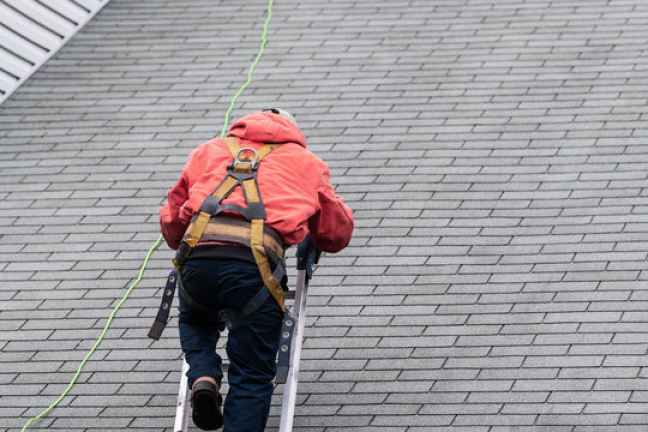After a storm or unexpected roof damage, filing an insurance claim can feel overwhelming. Homeowners often wonder what to expect when an insurance adjuster arrives for an inspection. Understanding the insurance adjuster roof evaluation process can help you prepare, ensuring you receive a fair assessment for any necessary repairs or replacements.
At Maycon Construction Services, we assist homeowners in navigating the Insurance Claims process efficiently. This guide explains what adjusters look for, how they assess damage, and what steps you can take to strengthen your claim.
The Role of an Insurance Adjuster
An adjuster is hired by the insurance company to evaluate the extent of the damage and determine how much of the repair costs will be covered. Their job includes:
- Verifying that the damage is caused by a covered event such as hail, wind, or storms.
- Assessing the roof’s current condition and expected lifespan.
- Identifying structural concerns or potential future risks.
- Submitting a detailed report to the insurance company for claim approval.
Key Areas Insurance Adjusters Inspect
Storm or Impact Damage
One of the first things an adjuster looks for is storm-related damage. This includes:
- Missing, cracked, or curled shingles caused by strong winds.
- Hail dents or punctures in shingles, flashing, or gutters.
- Fallen tree limbs or debris that may have led to roof punctures.
Why It Matters: Insurance typically covers sudden and accidental damage, but wear and tear may not qualify for reimbursement.
Granule Loss and Surface Wear
Shingle granules serve as a protective barrier against UV rays and moisture. Adjusters check for:
- Excessive granule buildup in gutters and downspouts.
- Bald spots or uneven discoloration on shingles.
Why It Matters: If granule loss is linked to storm damage, it can support your claim. However, if it’s due to aging, the insurance company may deny coverage.
Leaks and Interior Water Damage
Even if there are no visible exterior issues, leaks inside the home can indicate hidden roof damage. Adjusters inspect for:
- Water stains on ceilings and walls.
- Mold or mildew in the attic.
- Damp insulation or signs of wood rot.
Why It Matters: If a leak is traced back to storm damage, repairs are typically covered. If it’s due to a lack of maintenance, coverage may be limited.
Flashing and Sealant Condition
Flashing protects areas around chimneys, vents, and skylights from water intrusion. Adjusters examine:
- Loose, bent, or missing flashing.
- Cracked or deteriorated sealants.
- Gaps where water can enter.
Why It Matters: Damage from high winds or impact is usually covered, but deterioration from aging may not be included in your claim.
Structural Integrity and Roof Age
The condition and age of the roof can influence coverage. Adjusters evaluate:
- Sagging sections or weakened support beams.
- The age and material of the roofing system.
- Evidence of previous repairs or poor installation.
Why It Matters: If the roof was already in poor condition before the storm, the insurance company may only approve partial repairs.
How to Prepare for an Insurance Adjuster Roof Evaluation
Document the Damage
- Take clear photos of the roof before and after the storm.
- Note the date and details of the weather event.
- Gather any repair history or warranty information.
Schedule a Roofing Contractor Inspection
Before the adjuster arrives, a professional roofer can:
- Identify damage that could be overlooked.
- Provide an independent repair estimate.
- Assist in documenting the damage for your claim.
Having a professional involved can strengthen your Insurance Claims case.
Be Present During the Inspection
While you don’t need to follow the adjuster, being available allows you to:
- Point out specific areas of concern.
- Ask questions about the findings.
- Ensure no damage is overlooked.
What to Do If Your Insurance Claim Is Denied
If your claim is denied, you have options to challenge the decision:
- Request a Second Inspection – If you believe damage was missed, you can ask for a re-evaluation.
- Obtain a Professional Opinion – A trusted roofing contractor can provide additional documentation.
- Review Your Insurance Policy – Ensure the adjuster’s decision aligns with your coverage terms.
- File an Appeal – If necessary, submit additional evidence and formally contest the denial.
At Maycon Construction Services, we assist homeowners throughout the Insurance Claims process to ensure fair assessments and successful claims.
Conclusion
Understanding the insurance adjuster roof evaluation process helps homeowners prepare for inspections and increases the likelihood of a fair claim outcome. Adjusters assess storm damage, leaks, structural integrity, and overall roof condition before determining coverage.
By documenting damage, consulting a professional roofer, and being present during the inspection, you can improve your chances of receiving the compensation needed for repairs or replacements.
If you need expert guidance with your claim, Maycon Construction Services offers professional roof inspections and full-service support for homeowners navigating the insurance process.
Frequently Asked Questions
What happens during an insurance adjuster’s roof inspection?
The adjuster examines the roof for storm-related damage, structural issues, and signs of wear before submitting a report to the insurance company.
Can I challenge an insurance adjuster’s decision?
Yes, if your claim is denied or undervalued, you can request a second inspection, submit additional documentation, or appeal the decision.
Will insurance cover an old or worn-out roof?
Insurance typically covers storm damage but may not pay for a roof that is deteriorating due to age or neglect.
Should I hire a roofing contractor before the adjuster arrives?
Yes, having a professional inspection beforehand helps document damage properly and ensures nothing is overlooked.
What should I do if I suspect roof damage after a storm?
Take photos, check for interior water damage, and schedule a professional inspection before filing a claim.
How long does the insurance claim process take?
Most claims take a few weeks, but delays can occur if additional inspections or documentation are required.

